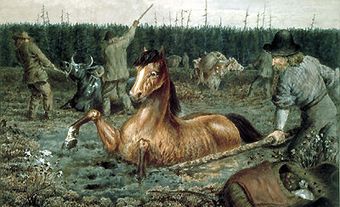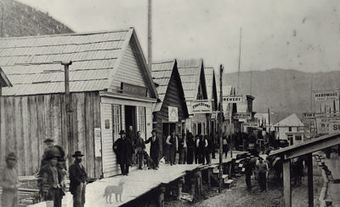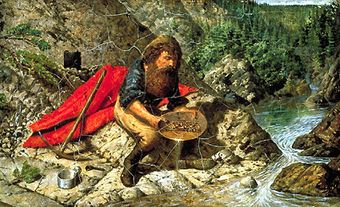Catherine Schubert (born 23 April 1835 in Rathfriland, County Down, Ireland; died 18 July 1918 in Armstrong, British Columbia). Catherine Schubert was the only female member of the 1862 Overlanders, a group of some 150 settlers who travelled from Fort Garry (now Winnipeg, Manitoba) to the interior of British Columbia, following the Cariboo Gold Rush.

Catherine O’Hare Schubert was the first European woman to travel overland from Fort Garry (now Winnipeg, Manitoba) to Kamloops, British Columbia.
(Courtesy Royal BC Museum, BC Archives /A-03081/virtualmuseum.ca)
Early Life and Move to North America
Catherine O’Hare was born in County Down, Ireland, in 1835. Her father, linen weaver James O’Hare, had trouble finding work because of the industrialization of the textile industry. The family’s circumstances were worsened by the Irish potato famine and a typhus epidemic in the 1840s. At the age of 16, Catherine, the youngest of the nine O’Hare children, enrolled in a domestic science course offered by the British government for young Irish women interested in immigrating to North America to become domestic servants. After crossing the Atlantic Ocean in steerage class, she worked as a maid in a wealthy household in Springfield, Massachusetts, where she learned to read in her spare time.
Marriage
In 1855, Catherine married Augustus Schubert (1826–1908), a carpenter who had immigrated to the United States from Dresden, Saxony (now Germany). The couple moved to St. Paul, the capital of the newly formed Minnesota territory, where Augustus worked as carpenter and Catherine ran a bakery and grocery store. There was unrest in the region, and a fur trader who visited the store, Norman Kittson, encouraged the family to emigrate to the Red River Settlement of Rupert’s Land, territory then held by the Hudson’s Bay Company.

“Tales Over the Camp Fire.” Sketch by artist William George Richardson Hind, July 1862. Hind kept a sketchbook while accompanying the Overlanders of 1862, who travelled
from Fort Garry [Winnipeg] to the interior of British Columbia in search of gold.
(Sketch by WGR Hind, courtesy Library and Archives Canada, Acc. No. 1963-97-1.40R)
Fort Garry and the “Overlanders”
The Schuberts moved to Fort Garry (now Winnipeg) in December 1860 with their children Augustus “Gus” (born 1856), Mary Jane (born 1858) and James “Jimmy” (born 1860). The family settled in St. Boniface, where they ran a small farm and general store. In 1861, the Schuberts lost their home and farm in a flood.
In May 1862, groups of men from Canada
West, Canada East, the United States, the United Kingdom and Australia arrived by paddle steamer in Fort Garry. They planned to travel west overland, following news of the
Cariboo
Gold Rush in British
Columbia. In Fort Garry, they organized into a single party of approximately 150 people, led by Thomas McMicking. The Schuberts decided to join the party and seek their fortune out west.
Mark Sweeten Wade, a medical officer with the Canadian Pacific Railway and historian, interviewed surviving “Overlanders” in the early 20th century. According to Wade, Augustus Schubert was determined to join the party and travel to Cariboo to seek his fortune. Moreover, “Mrs. Schubert was equally determined that he should not go alone, but that the entire family should share the perils of the journey, the outcome being that the rule that no women be included in the expedition was suspended for her benefit.” Catherine did not reveal that she was expecting her fourth child, assuming that the party would arrive at their destination before the baby arrived.
Did you know?
Artist William George Richardson Hind also accompanied the Overlanders and kept a sketchbook on the journey. He later painted a series of watercolours. He recorded the party fording streams, hunting buffalo and passing the time while in camp. Hind later produced a series of paintings of the journey and life in the west, including mining in the Cariboo.

“Edmonton and Saskatchewan River.” Sketch by artist William George Richardson Hind, August 1862.
(Sketch by WGR Hind, courtesy Library and Archives Canada, Acc. No. 1963-97-1.66R)
Overland to British Columbia
Catherine Schubert travelled west on horseback with Gus and Mary Jane in saddle baskets on either side while Augustus carried Jimmy. The Overlanders experienced poor weather, mosquitos and a flooded Saskatchewan River. Later in life, Gus recalled the “never-ending squeaks and groans of the Red River carts" carrying their belongings as the family traveled 1600 km west across the prairies to Fort Edmonton. There, the Overlanders traded for more horses and food and hired a Métis guide, André Cardinal, for the journey through Yellowhead Pass in the Rocky Mountains to Tête Jaune Cache on the Fraser River. The mountain trails were narrow, and horses fell to their death. The Schuberts forded icy rivers and crawled along narrow mountain passes with their children strapped to their backs.
According to fellow Overlander Alexander Fortune, "Great sympathy was manifested for the brave and devoted mother of those three children. Her presence in the company helped cultivate a kindly and more manly treatment of man to man." The presence of Catherine and her children also reassured First Nations communities along the journey that the Overlanders were not a war party and that they travelled with peaceful intentions.

“Cure for Rheumatism.” Sketch by artist William George Richardson Hind, July 1862. The sketch shows three men beside a slain bison. One man is possibly Métis as indicated by his red sash and another is possibly First Nation.
(Sketch by WGR Hind, courtesy Library and Archives Canada, Acc. No. 1963-97-1.43R)
Arrival in Kamloops
On 2 September 1862, the Schuberts departed Tête Jaune Cache with 36 other Overlanders. They intended to raft down the Thomson River to Kamloops. (The other members of the expedition rafted down the Fraser River). The Thomson River journey took six weeks as the Schuberts and the rest of their party faced dangerous river conditions. They lost the canoe containing their food and other supplies, forcing them to forage for edible plants in the surrounding forest.
On 14 October 1862, Catherine went into labour just outside of Fort Kamloops. Women from the Shuswap First Nation assisted at the birth. According to the diary of Overlander Mr. DeWitt, “The poor woman was here confined and presented her husband with a fine little girl, much to the surprise of many of the party.” The Schuberts considered naming their newborn daughter Kamloops but instead chose the name Rose because of the wild rosehips that had kept them from starvation the during the last weeks of their journey.
The captain of the expedition, Thomas McMicking, praised Catherine in his journal, writing, “In performing this journey, Mrs. Schubert has accomplished a task to which but few women are equal; and with the additional care of three small children, one which but few men would have the courage to undertake.” At Fort Kamloops, the Schuberts worked for the Hudson’s Bay Company over the winter of 1862–63, Augustus as a carpenter and Catherine as a cook.
Later Life
The Schuberts became the parents of two more children, Charles (born 1870) and Catherine Honora “Nora” (born 1872). Catherine ran an inn and restaurant in Lillooet while Augustus spent the summers prospecting for gold in Quesnel, with little success. Catherine also taught local children in her home and practised midwifery. In 1881, Augustus ended his search for gold and the family purchased a farm in the Okanagan Valley. The Schuberts built a school on their property and convinced the British Columbia government to send a teacher to the Okanagan Valley in 1885. After Augustus died of a fall from a ladder in 1908, Catherine sold the farm and moved to Armstrong, British Columbia. She died in 1918.
Legacy
A memorial unveiled on 1 July 1926 in Armstrong is inscribed with the words, “In honour of Catherine Schubert who in company with her husband and three small children was a member of the hazardous overland expedition of 1862 across the Canadian Rockies from Fort Garry to Kamloops. A Brave and Notable Pioneer.” A 2003 statue in Kamloops depicts Augustus and Catherine Schubert with one of their children. Schubert Drive in Kamloops is named for the family.

“Crossing the Pembina River.” Sketch by artist William George Richardson Hind, August 1862.
(Sketch by WGR Hind, courtesy Library and Archives Canada, Acc. No. 1963-97-1.85R)

 Share on Facebook
Share on Facebook Share on X
Share on X Share by Email
Share by Email Share on Google Classroom
Share on Google Classroom


